If there’s one thing Disney Parks thrillseekers know to look for, it’s a mountain peak. After all, since Disneyland’s first decade, the connection between Disney and its mountainous thrills has become second nature. In fact, we took an in-depth look at Disney’s best “E-Ticket” peaks in their own Countdown: Peaks of Imagineering, summiting the twelve best Disney Parks mountains across the globe and how their headlining thrill rides stack up. What do you think we ranked as the top three “mountain” rides in the world? That special feature is a good place to start if you haven’t already…
Because today’s look is somewhat different. For years, our Possibilityland series has explored the incredible archives of Imagineering to dive deep into never-built masterpieces that could’ve been hits… We’re talking about the shuttered Muppet Studios once planned for the Disney-MGM Studios, a gritty New Tomorrowland 2055 once planned for Disneyland, and so many more. But this feature is special… Seriously…
And today, in this very special Possibilityland feature, we want to look at ten, never-built, E-Ticket “mountains” proposed for – then cancelled from – Disney Parks around the globe. Check out these cancelled classics and consider: what would your favorite Disney Parks be like today if these towering mountain peaks had risen over the skyline?
And before we head off, remember that you can unlock rare concept art and audio streams in this story, access over 100 Extra Features, and recieve an annual Membership card and postcard art set in the mail by supporting this clickbait-free, in-depth, ad-free theme park storytelling site for as little as $2 / month! Become a Park Lore Member to join the story! Until then, let’s start at the beginning…
1. Fire Mountain

Proposed location: Magic Kingdom
When Magic Kingdom’s adored Lost Legend: 20,000 Leagues Under the Sea closed in 2004, it appeared to be the end of Jules Verne’s influence in the park’s ride lineup. However, Imagineers were actually hard at work on a follow-up attraction: Fire Mountain. Yes, joining the likes of Space, Splash, and Big Thunder, a new volcanic peak would’ve arisen over Magic Kingdom’s skyline just in time to combat the opening of Universal’s Islands of Adventure…
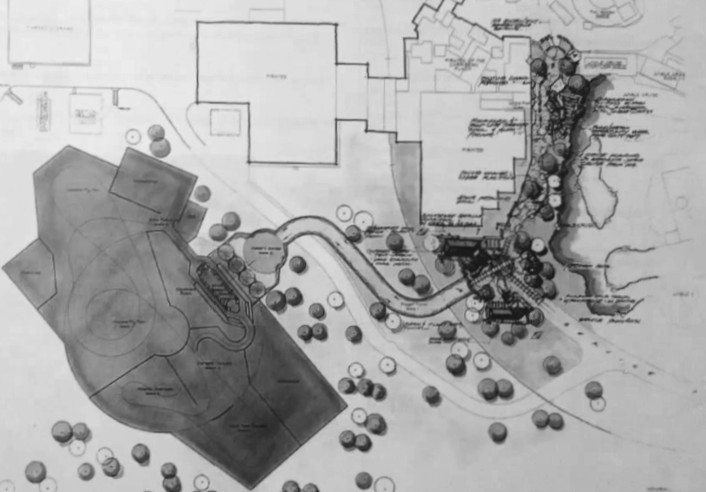
In fact, the looming Fire Mountain would’ve been the anchor of an entire new sub-section of Magic Kingdom’s Adventureland. Guests would be lead down a narrow jungle pathway between the banks of the Jungle Cruise and the Pirates of the Caribbean showbuilding, crossing under the Walt Disney World Railroad (a setup nearly identical to Disneyland’s Modern Marvel: Indiana Jones Adventure). There, in a new expansion outside of the park’s existing layout, an entire new Jules Verne inspired base camp would recreate Volcania – secret lair of 20,000 Leagues’ Captain Nemo.
Cleverly, this steampunk, literary expedition base camp (incorporating elements of the never-built Possibilityland: Discovery Bay). That means that the famously scientific exploits of Captain Nemo and his world would’ve joined the genres of adventure already present in Adventureland – misty jungles, quirky Polynesia, epic pirates, and now, science fiction and Earth exploration. Fire Mountain would be a high-speed roller coaster ride through the peak.
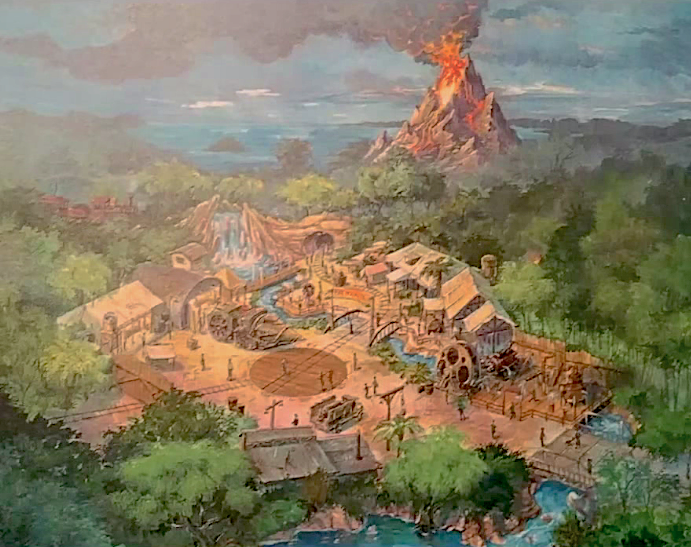
In 1998, Disney’s preferred coaster manufacturer – Vekoma – unveiled its newest ride system, the Flying Dutchman. By 1999, plans for Fire Mountain had morphed to match. Rather than retaining its Jules Verne / “Journey to the Center of the Earth” theme, Volcania would instead be the 1912 base camp of the Whitmore Expedition from Disney’s planned film, Atlantis: The Lost Empire.
Atlantis, it was believed, would be Disney’s first entry in its own Jules Verne style universe of sci-fi adventure films, reclaiming the audience of the Disney Renaissance and beginning a new era of animation, so overlaying the adventurous IP over the Fire Mountain plans seemed like an obvious fit.
The “new” Fire Mountain concept called for Vekoma’s Flying Dutchman coaster system that would begin as a typical roller coaster…
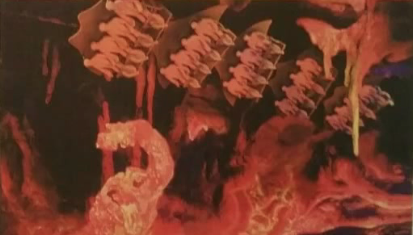
… before the seats would lower halfway through, with a twist in the track positioning riders face-down in “flying” position for a race through the mountain’s core. Imagineers crafted an entire story and layout for the ride based off the storyboards for the finale of Atlantis, leaping through magma-falls, swinging up for near-misses with cavern walls, and diving helplessly toward boiling lava.
Disney even floated height test balloons (a common first step in construction) to be sure that the mountain wouldn’t be obtrusively visible from elsewhere in the park.
WHAT HAPPENED? Anything that could’ve gone wrong with Fire Mountain did. First of all, Atlantis wildly under-performed at the box office, cooling any push for the IP in Disney Parks. Second of all, the purpose for the ride’s design — the impending threat of Universal’s Islands of Adventure — turned out to be a non-issue when Universal botched its 1999 park’s marketing. Third, the decimation of the tourism industry after September 11, 2001 assured that Fire Mountain was done for… Except…
Recently, rumbling rumors suggest that Fire Mountain is back on Disney’s short list of potential projects, this time tied to the award-winning film Moana… And speaking of which, that height test Disney did to see if the volcano would be visible? It wasn’t from Main Street… but the volcano would practically loom over Disney’s Polynesian Village Resort. Hmm…
2. Discovery Mountain
Proposed location: Disneyland Paris
When Disney’s Imagineers started work on EuroDisneyland, they knew that they faced an uphill battle to legitimize the Parisian park. The French media turned against the “American imperialism” of a Disney property in Paris early on, leaving designers in the unusual position of having to downplay the Americana inherent in Disneyland… which, at its core, is an icon of American enterprise whose themed lands are essentially time capsules of American pop culture, heritage, and pride.

The most profound switch was that Disneyland Paris didn’t have a Tomorrowland at all, since Europeans would find little interest in the sleek, geometric, white, concrete land of NASA, circling rockets, and the optimism of the Space Race. Instead, the land was reborn as Discoveryland, based on plans for a never-built expansion of Disneyland California – the Possibilityland: Discovery Bay.
A glowing, golden nautical port inspired by Jules Verne, Discoveryland featured bubbling lagoons with the docked Nautilus, hovering zephyrs, organic rockwork, brass plates and cogs, and hot air balloons. Since a sleek, white, Space Mountain wouldn’t fit in this golden retro-future, designers drafted Discovery Mountain. A land-within-the-land, this enormous, self-contained steampunk paradise would’ve contained multiple attractions themed to Jules Verne novels…
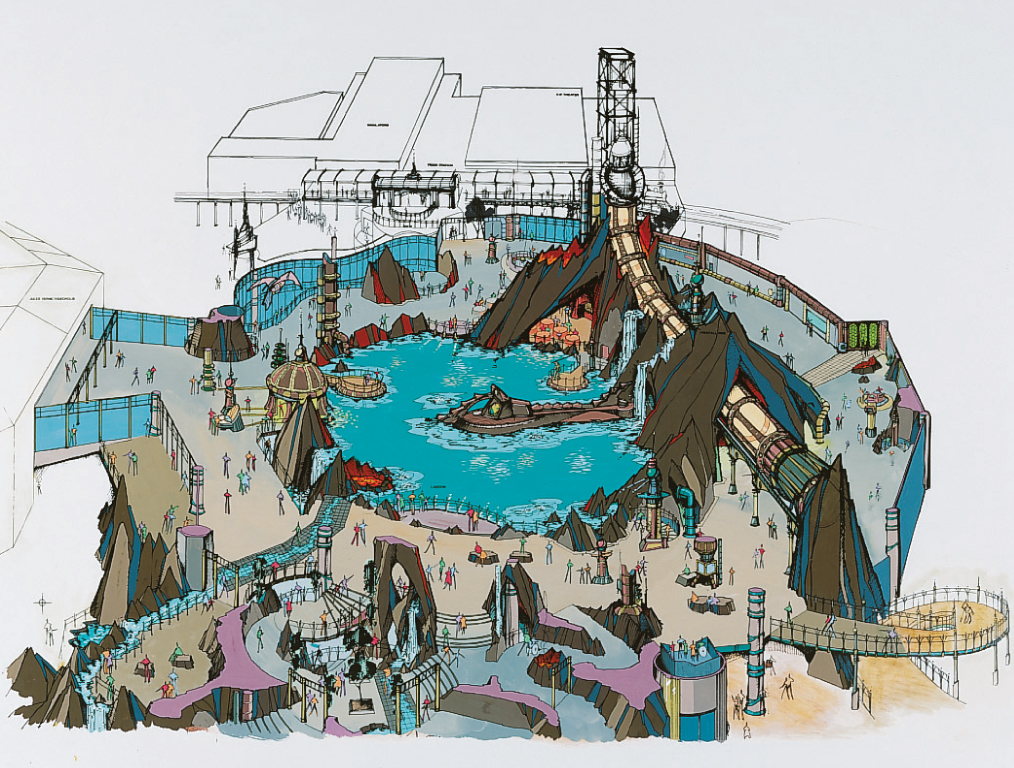
…like a first generation free-fall drop ride based on Journey to the Center of the Earth, a walk-through tour of the Nautilus from 20,000 Leagues Under the Sea, and a custom-built roller coaster through the stars themed to From the Earth to the Moon.
WHAT HAPPENED? Ultimately, the overbuilt Disneyland Paris fell into a financial freefall. Its budget was so bad, it infamously made then-CEO Michael Eisner wary of any large scale projects to follow. That’s why – in Paris’ wake – dozens of projects were cancelled or closed. Though Imagineers had intentionally left Discovery Mountain out so that they could build it when the park needed a re-awakening of public interest, Disneyland Paris needed something new now.
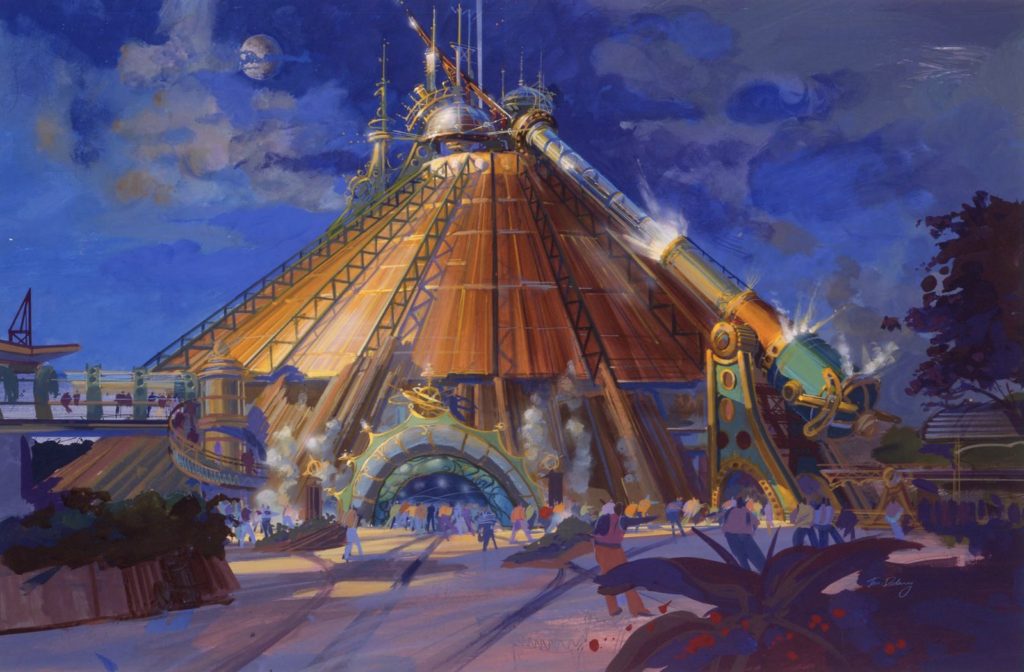
Discovery Mountain was “downgraded” to the scale of a typical Space Mountain, but retained the beautiful, Jules Verne inspired exterior and story, becoming a Lost Legend: Space Mountain – De la Terre à la Lune, which eventually fell to the same scientific styling as the other Space Mountains (and even a current and seemingly-permanent Star Wars overlay), just in a much more elaborate shell.
3. Geyser Mountain

Proposed location: Disneyland and Disneyland Paris
In the 2000s, Disney Imagineers were prepped for everything to change. Disney’s California Adventure Park was poised for a 2001 opening, and executives were sure that the brand-new second gate at the renamed Disneyland Resort would turn the California property into an international destination. Crowds would practically swarm the new, hip, edgy park, desperate to see what Disney had created. In comparison to the modern, cool California Adventure with its “MTV attitude,” old, dusty Disneyland would practically be a graveyard.
That’s why Imagineers set to work developing a new attraction that would help even the odds, bringing people back to the antique 1950s park. Brilliantly, they decided to re-use the technology they’d developed for the Disney-MGM Studios’ headlining thrill ride to create an explosive drop tower inside of a geothermal peak in the park’s Frontierland.
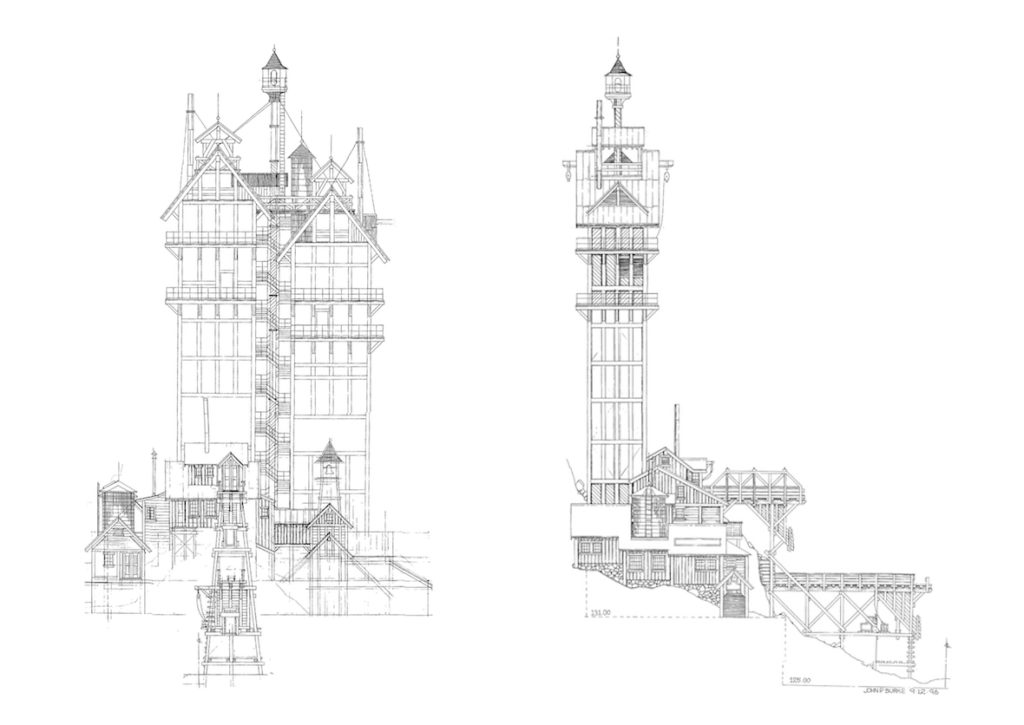
Old mining elevators would descend through the mountain, opening to reveal crystal caverns and steaming subterranean chambers before the mountain’s most untrustworthy geyser, “Old Unfaithful,” would erupt, launching riders sky-high for park-wide views. Interestingly, Geyser Mountain would’ve made Disneyland the most-mountainous park in Disney’s catalogue (with Space, Splash, Big Thunder, Matterhorn, and Geyser).
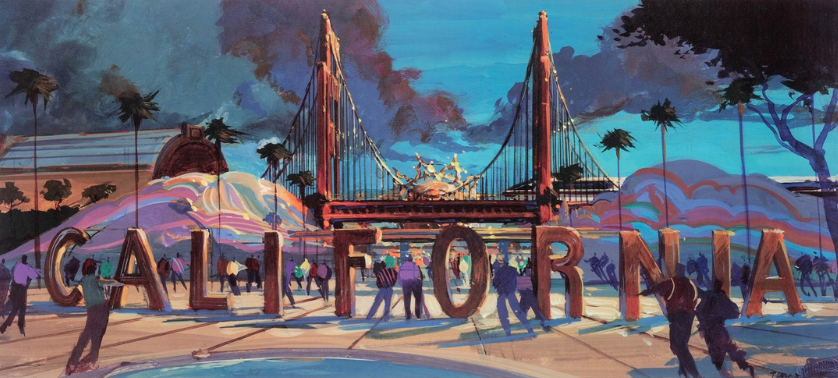
WHAT HAPPENED? Of course, things didn’t quite work out as expected… In our in-depth Declassified Disaster: Disney California Adventure feature, we dissected the unfortunate fate of Disney’s costliest mistake ever, but to make a very long story short, people were not flocking to Disney’s new park. Contrary to what executives expected, it was the brand new California Adventure that needed the boost! Better yet, there was no need to reinvent the wheel with an ambitious original project like Geyser Mountain… the already-tried-and-true Hollywood Tower Hotel from the Disney-MGM Studios would be a perfect fit for the Californian park!
After the September 11, 2001 terrorist attacks on New York, however, tourism came to a halt and Disney slashed budgets and cut projects across the parks division. California Adventure still needed a boost badly, but now the Tower of Terror it received would need to be a new, budget-friendly version – a story we told in-depth in one of the site’s most popular features, Lost Legends: The Twilight Zone Tower of Terror.
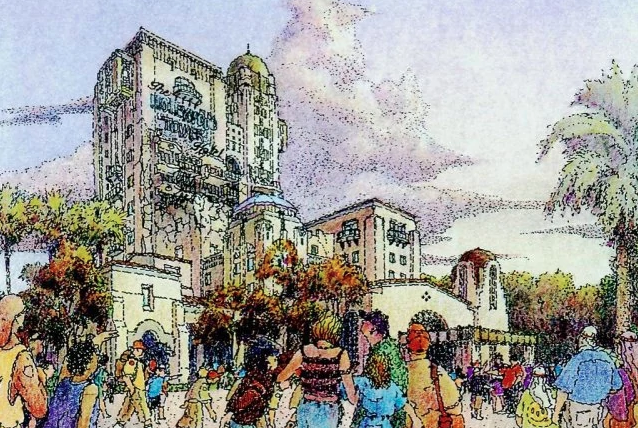
Disney still planned to bring Geyser Mountain to life at Disneyland Paris, where it would take the form of a giant drilling rig, but then the French resort’s second park needed an even bigger boost than California Adventure did! Thus, the less-expensive Californian version of The Twilight Zone Tower of Terror was duplicated in Paris’ abysmal second gate – another Declassified Disaster: Walt Disney Studios Park – meaning Geyser Mountain never saw the light of day.






